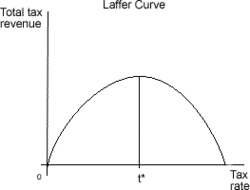Laffer curve
|
|
The Laffer curve, developed by economist Arthur Laffer and often used to justify tax cuts, is intended to show that government can maximize tax revenue by setting a tax rate at the peak of this curve. The curve is clearly accurate at both extremes of taxation --zero percent and one-hundred percent-- where the government collects no revenue. At one extreme, a 0% tax rate means the government's revenue is, of course, zero. At the other, where there is a 100% tax rate, the government collects zero revenue because taxpayers have no incentive to work or avoid taxes and the government collects 100% of nothing. Somewhere between 0% and 100%, therefore, lies a tax rate percentage that will maximize revenue.
The point at which the curve achieves its maximum will vary from one economy to the next and is subject to much theoretical speculation. Another contentious issue is whether a government should try to maximise its revenue in the first place.
The Laffer curve concept is central to the supply side economics.
Context in US History
The Laffer curve and supply side economics inspired the Kemp-Roth Tax Cut of 1981. Supply-side advocates of tax cuts claimed that lower tax rates would generate more revenue because government was operating on the right-hand side of the curve. Conventional economic paradigms acknowledge the basic notion of the Laffer curve, but argue that government was operating on the left-hand side of the curve, so a tax cut would thus lower revenue. The central question is the elasticity of work with respect to tax rates.
At least one empirical study, looking at actual historical data on tax rates, GDP, and revenue, placed the 'optimal' tax rate (the point at which another marginal tax rate increase would decrease tax revenue) as high as 80%. Paul Samuelson argues in his popular economic textbook that Ronald Reagan was correct in a very limited sense to view the intuition underlying the Laffer curve as accurate, because as a successful actor, Reagan was subject to marginal tax rates as high as 90% during World War II. The point is that in a progressive tax system, any given person's perspective on the validity of the Laffer curve will be influenced by the marginal tax rate to which that person's income is subject.
In the United States, some claimed that both tax cuts and government spending policies of the 1980s were the cause of large budget deficits. Others claim that the data actually shows United States government revenues increased during that period, suggesting that deficits were unrelated to tax cuts, and should be attributed to increased spending alone. The counter-argument is that the income only increased along with growth in GNP at a rate roughly consistent with other 20th century decades. At the same time the federal government commitments to services such as Social Security rose along with population growth. During the Clinton administration government revenues and GNP increased at an even higher rate despite increases in taxes.
David Stockman, Reagan's budget director during his first administration and one of the early proponents of supply-side economics, maintained that the Laffer curve was not to be taken literally - at least not in the economic environment of the 1980s United States. In "The Triumph of Politics" he writes:
"[T]he whole California gang had taken [the Laffer curve] literally (and primitively). The way they talked, they seemed to expect that once the supply-side tax cut was in effect, additional revenue would start to fall, manna-like, from the heavens. Since January, I had been explaining that there is no literal Laffer curve."
Rumour suggests the Laffer Curve was originally sketched on a restaurant napkin in the late 1970s as Art Laffer and Robert Mundell described the concept to Jude Wanniski.
Precedents to the Laffer Curve
The idea inherent in the Laffer curve has been described many times prior to Laffer, including:
- The French economist Frédéric Bastiat (19th century)
- The Islamic scholar Ibn Khaldun (14th century)
See also
de:Laffer-Kurve eo:Kurbo de Lafero fr:Courbe de Laffer ja:ラッファー曲線 pl:Krzywa Laffera

